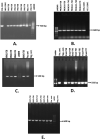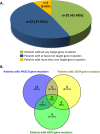Mutational profiles of marker genes of cervical carcinoma in Bangladeshi patients
- PMID: 33736612
- PMCID: PMC7977314
- DOI: 10.1186/s12885-021-07906-5
Mutational profiles of marker genes of cervical carcinoma in Bangladeshi patients
Abstract
Background: Cervical cancer is a gynecologic cancer type that develops in the cervix, accounting for 8% mortality of all female cancer patients. Infection with specific human papillomavirus (HPV) types is considered the most severe risk factor for cervical cancer. In the context of our socioeconomic conditions, an increasing burden of this disease and high mortality rate prevail in Bangladesh. Although several researches related to the epidemiology, HPV vaccination, and treatment modalities were conducted, researches on the mutation profiles of marker genes in cervical cancer in Bangladesh remain unexplored.
Methods: In this study, five different genomic regions within the top three most frequently mutated genes (EGFR, KRAS and PIK3CA) in COSMIC database with a key role in the development of cervical cancers were selected to study the mutation frequency in Bangladeshi patients. In silico analysis was done in two steps: nucleotide sequence analysis and its corresponding amino acid analysis.
Results: DNA from 46 cervical cancer tissue samples were extracted and amplified by PCR, using 1 set of primers designed for EGFR and 2 sets of primers designed for two different regions of both PIK3CA and KRAS gene. In total, 39 mutations were found in 26 patient samples. Eleven different mutations (23.91%), twenty-four different mutations (52.17%) and four mutations (8.7%) were found in amplified EGFR, PIK3CA and KRAS gene fragments, respectively; among which 1 (EGFR) was common in seven patient samples and 2 (PIKCA) were found in more than 1 patient. Our study shows that except for KRAS, the frequency of observed mutations in our patients is higher than those reported earlier in other parts of the world. Most of the exonic mutations were found only in the PIK3CA and EGFR genes.
Conclusions: The study can be used as a basis to build a mutation database for cervical cancer in Bangladesh with the possibility of targetable oncogenic mutations. Further explorations are needed to establish future diagnostics, personalized medicine decisions, and other pharmaceutical applications for specific cancer subtypes.
Keywords: Cervical cancer; EGFR; HPV; KRAS; Mutation; PIK3CA.
Conflict of interest statement
The authors declare that they have no conflict of interest.
Figures




Similar articles
-
Detection of oncogenic mutations in cervical carcinoma using method High Resolution Melting (HRM).Neoplasma. 2016;63(5):779-88. doi: 10.4149/neo_2016_516. Neoplasma. 2016. PMID: 27468883
-
Oncogenic mutations in cervical cancer: genomic differences between adenocarcinomas and squamous cell carcinomas of the cervix.Cancer. 2013 Nov 1;119(21):3776-83. doi: 10.1002/cncr.28288. Epub 2013 Aug 23. Cancer. 2013. PMID: 24037752 Free PMC article.
-
Epidermal growth factor receptor pathway mutation and expression profiles in cervical squamous cell carcinoma: therapeutic implications.J Transl Med. 2015 Jul 25;13:244. doi: 10.1186/s12967-015-0611-0. J Transl Med. 2015. PMID: 26209091 Free PMC article.
-
KRAS mutation testing of colorectal cancer for anti-EGFR therapy: dogmas versus evidence.Curr Cancer Drug Targets. 2010 Dec;10(8):813-23. doi: 10.2174/156800910793357989. Curr Cancer Drug Targets. 2010. PMID: 20718705 Review.
-
Exploiting somatic alterations as therapeutic targets in advanced and metastatic cervical cancer.Cancer Treat Rev. 2021 Jul;98:102225. doi: 10.1016/j.ctrv.2021.102225. Epub 2021 May 23. Cancer Treat Rev. 2021. PMID: 34082256 Free PMC article. Review.
Cited by
-
A comparative analysis of somatic mutational profiles according to HIV status among women with cervical intraepithelial neoplasia 3 (CIN3): a focus on hotspots in TP53, PIK3CA, PTEN, and EGFR.Infect Agent Cancer. 2025 Mar 17;20(1):18. doi: 10.1186/s13027-025-00647-1. Infect Agent Cancer. 2025. PMID: 40091081 Free PMC article.
-
Molecular markers predicting the progression and prognosis of human papillomavirus-induced cervical lesions to cervical cancer.J Cancer Res Clin Oncol. 2023 Aug;149(10):8077-8086. doi: 10.1007/s00432-023-04710-5. Epub 2023 Mar 31. J Cancer Res Clin Oncol. 2023. PMID: 37000261 Free PMC article. Review.
-
Mediation of circ_0007142 on miR-128-3p/S100A14 pathway to stimulate the progression of cervical cancer.Naunyn Schmiedebergs Arch Pharmacol. 2024 Dec;397(12):9919-9933. doi: 10.1007/s00210-024-03250-0. Epub 2024 Jun 29. Naunyn Schmiedebergs Arch Pharmacol. 2024. PMID: 38951152
-
Peptide Vaccines as Therapeutic and Prophylactic Agents for Female-Specific Cancers: The Current Landscape.Pharmaceuticals (Basel). 2023 Jul 24;16(7):1054. doi: 10.3390/ph16071054. Pharmaceuticals (Basel). 2023. PMID: 37513965 Free PMC article. Review.
-
Genotypic distribution and prevalence of human papillomavirus infection in an apparently healthy female population in Bangladesh.IJID Reg. 2021 Oct 21;1:130-134. doi: 10.1016/j.ijregi.2021.10.005. eCollection 2021 Dec. IJID Reg. 2021. PMID: 35757826 Free PMC article.
References
-
- Bernard WS, Christopher PW. World cancer report 2014. World Health Organization. 2014.
-
- Division of Cancer Prevention and Control, Centers for Disease Control and Prevention (CDC). Cervical Cancer Statistics. Retrieved from https://www.cdc.gov/cancer/cervical/statistics/index.htm. 2014.
-
- Canavan TP, Doshi NR. Cervical cancer. Am Fam Physician. 2000;61(5):1369–1376. - PubMed
Publication types
MeSH terms
Substances
LinkOut - more resources
Full Text Sources
Other Literature Sources
Medical
Research Materials
Miscellaneous

